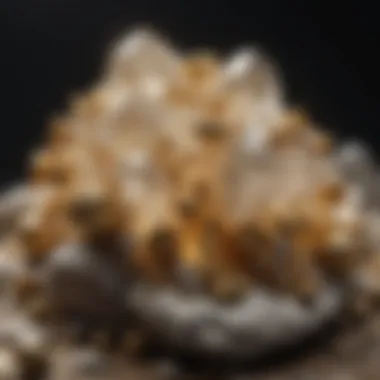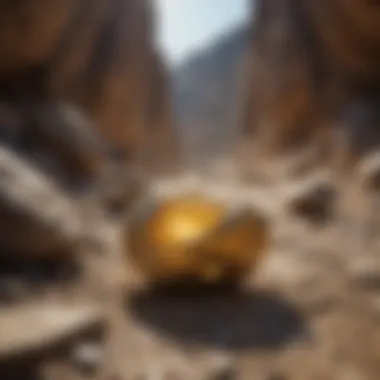The Interrelationship between Quartz and Gold


Intro
The relationship between quartz and gold is complex, yet fascinating. Both minerals often coexist in the Earth’s crust, giving rise to unique geological formations and economic opportunities. This interdependence not only has implications for geology but also significantly influences the market for various collectibles.
In this article, we will journey through the historical and geological contexts of quartz and gold, uncover their extraction processes, and assess their economic significance. Enthusiasts and collectors alike will find value in understanding how these minerals interact and the role they play in our world today.
History and Origins
Overview of Collectibles, Rocks, and Fossils
Throughout history, quartz and gold have held pivotal roles in human civilization. Quartz is prized not only for its beauty but also for its utility. Gold, on the other hand, has been universally recognized for its rarity and has often served as a basis for currency and trade. As collectibles, both minerals captivate rock and fossil enthusiasts, creating a rich tapestry of history and cultural significance.
Historical Significance and Cultural Impact
Gold has often been associated with wealth and power. From ancient Egyptian tombs to the riches of the Aztec empire, gold has been a sought-after resource. Likewise, quartz has been utilized by various cultures for tools, decorative items, and spiritual artifacts. The interplay between these two minerals can be seen in various historical contexts, such as gold veins found within quartz deposits that were mined for hundreds of years.
"The allure of gold, embedded within quartz, has continued to inspire collectors and geologists alike, serving as a reminder of nature's complexities."
Identification and Classification
Guide to Identifying Rocks and Fossils
Identifying quartz and gold requires a keen eye. For rock collectors, the distinctive features of quartz, such as its crystal structure and hardness, are key indicators. Gold, with its metallic luster and weight, can often be distinguished from other minerals. Successful identification often hinges on a few crucial traits:
- Color: Gold is typically yellow, while quartz can appear in various colors.
- Luster: Gold exhibits a metallic sheen, whereas quartz is glassy.
- Hardness: Quartz rates a 7 on the Mohs scale, while gold is softer.
Common Types and Variations
Quartz exists in numerous forms, including rose quartz, amethyst, and smoky quartz, each with unique properties. Gold too can vary, often found in forms such as nugget gold or wire gold.
In understanding these differences, collectors can appreciate the diverse forms these minerals take.
By dissecting the geological and economic aspects of quartz and gold, we aim to provide a comprehensive perspective. Join us as we delve deeper into the extraction methods, environmental implications, and the significance of these minerals in the collectibles market.
Foreword to Quartz and Gold
Understanding the interplay between quartz and gold is essential for various fields, particularly geology, mining, and economics. This relationship sheds light on not only the formation of these minerals but also their significance in the market and history. Quartz, recognized for its durability and abundance, often acts as a host for gold deposits, impacting extraction techniques and yields. Gold, on the other hand, captivates with its economic allure and historical value, driving demand in various sectors, including finance and jewelry.
The investigation of quartz and gold offers multiple benefits, especially for rock and fossil collectors. Knowledge of their geological formations can enhance collecting efforts by guiding the search for valuable specimens. Furthermore, understanding the economic implications aids in making informed decisions in both collection and investment.
While both minerals are distinct in their properties and uses, their connection is evident. Mining practices exploit this relationship to maximize efficiency in extracting gold. By delving into this interrelationship, one can grasp not only the scientific processes involved but also the cultural and economic narratives entwined with quartz and gold.
Defining Quartz
Quartz is among the most prevalent minerals in the Earth's crust, composed primarily of silicon dioxide (SiO2). It exhibits remarkable chemical stability and can be found in various forms, such as crystals, fine particles in sand, and as a component of igneous, metamorphic, and sedimentary rocks. Its hardness, rated at 7 on the Mohs scale, makes quartz durable and resistant to weathering. This durability enhances its presence in diverse environments, making quartz a common find for collectors.
In addition to its geological prominence, quartz has a wide range of applications. Beyond its importance in industrial processes, it possesses aesthetic values that appeal to collectors. The clarity and color variations found in quartz crystals, such as amethyst or citrine, make them highly sought after.
Defining Gold
Gold is a rare element, with the atomic number 79. This metal is valued not only for its beauty but also for its malleability and conductivity. Gold forms naturally in the Earth, typically found in its native form, often in alluvial deposits or as a part of quartz veins. Its scarcity contributes to its historical use as a currency and a symbol of wealth.
The unique properties of gold make it essential across various industries. It is widely used in electronics, aerospace, and specifically in jewelry due to its lustrous appeal. Moreover, gold has a significant role in the global economy, often seen as a safe-haven asset during economic instability. For collectors, the allure of gold goes beyond its economic value; it embodies a rich history intertwined with human culture, making it a prized specimen in any collection.
"Gold is the most malleable of all metals, making it a preferred material for intricate designs in jewelry and various artifacts."


Geological Formation
The geological formation of quartz and gold plays a significant role in understanding their intricate connection. By examining how these two minerals develop, we can gain insights into their properties, occurrences, and the methods employed for their extraction. Geological factors influence the formation processes and ultimately affect their economic importance to various industries, such as jewelry, technology, and collectibles.
Formation of Quartz
Quartz is primarily composed of silicon dioxide (SiO2) and is known for its abundance in the Earth's crust. Its formation occurs through various geological processes. One primary method is crystallization from molten rock during the cooling phase of igneous rocks. Quartz can also form through metamorphic processes, where silica is mobilized under heat and pressure. Additionally, sedimentary processes can contribute to quartz deposition, especially in riverbeds and sandy environments.
Key factors in the formation of quartz include:
- Temperature and pressure: High conditions lead to the crystallization of quartz, influencing its purity and clarity.
- Chemical environment: The availability of silica in the surrounding environment directly impacts quartz formation.
- Time: The slower the cooling process, the larger the quartz crystals can grow.
Overall, quartz's formation is a vital component of geological studies, affecting both its physical properties and its role in gold deposition.
Formation of Gold Deposits
Gold forms through both primary and secondary processes, contributing significantly to its geological uniqueness. Primary gold deposits are typically found in rock formations where it has crystallized from hydrothermal fluids. This process often occurs in areas with significant tectonic activity, where heated water rich in gold ions moves through fractures and cools to form veins of gold.
Secondary gold deposits, on the other hand, are the result of weathering and erosion. Over time, these processes can liberate gold from surrounding rock, making it easier to accumulate in alluvial deposits such as riverbeds.
Critical elements in the formation of gold deposits are:
- Hydrothermal activity: This is a prominent process for forming primary gold deposits.
- Age of rock formations: Older formations often reveal significant gold deposits.
- Tectonic settings: Regions prone to tectonic shifts can present favorable conditions for gold deposition.
Gold's geological formation not only underscores its rarity but also emphasizes the delicate interplay between geological activities and the creation of precious resources.
Quartz and Gold: A Symbiotic Relationship
Quartz and gold share a compelling symbiotic relationship within geological settings. The presence of quartz can often indicate potential gold deposits, as they both influence each other's formation and location. Gold frequently deposits within quartz veins, where quartz acts as a host mineral. This relationship shows how these two minerals coexist in certain geological environments, creating opportunities for exploration and mining.
The interaction between quartz and gold is important for several reasons:
- Indicator mineral: The presence of quartz can signal the likelihood of finding gold nearby.
- Mining efficiency: Understanding this relationship improves gold extraction strategies.
- Economic relevance: Their combined presence enhances the economic viability of mining operations, as quartz can also be utilized in various industrial applications.
In summary, the geological formation of quartz and gold provides valuable knowledge for collectors, geologists, and miners. By exploring how these minerals form, we can better understand their economic significance and potential applications in various fields.
Mineral Properties
Understanding the mineral properties of quartz and gold is essential in appreciating their roles in geology and economy. These properties define how these minerals respond to various natural processes and human interactions. For rock and fossil collectors, recognizing these characteristics aids in identifying specimens and evaluating their potential value. This section will delve into the physical characteristics of both minerals, followed by a comparative analysis that highlights their differences and similarities.
Physical Characteristics of Quartz
Quartz is one of the most abundant minerals in Earth's crust. Its crystal structure is classified as trigonal, characterized by a six-sided prism ending in a six-sided pyramid. This unique formation contributes to its significant hardness, rated at 7 on the Mohs scale. This hardness makes quartz resistant to weathering, preserving its form in various environments.
The color of quartz can vary widely, influenced by impurities. Common varieties include clear quartz, rose quartz, and smoky quartz. Its transparency and luster vary; when light interacts with it, quartz can exhibit a glassy sheen. Additionally, its optical properties, such as birefringence, allow it to split light, creating beautiful optical effects, especially in gem-quality specimens. Understanding these attributes provides collectors insights into evaluating quartz's quality and rarity.
Physical Characteristics of Gold
Gold is a unique metal known for its malleability and ductility. It ranks 19.3 in density, significantly heavier than many other minerals, which makes it valuable for all sorts of applications. Gold's softness allows it to be shaped easily, making it a favorite for crafting jewelry and coins.
The distinctive yellow hue is one of gold's hallmarks, produced by its atomic structure. Gold has a remarkable resistance to tarnish and corrosion; this quality contributes significantly to its longevity in artifacts and jewelry. On the Mohs scale, gold is rated at about 2.5 to 3, which indicates its softness relative to other minerals. Its properties enable it to maintain appearance over time, adding to its allure for collectors and investors alike.
Comparative Analysis of Quartz and Gold
When contrasting quartz and gold, several key differences and similarities emerge:
- Chemical Composition: Quartz is composed primarily of silicon dioxide (SiO2), while gold is a pure element with the symbol Au.
- Crystal Structure: Quartz crystallizes in a trigonal system, whereas gold is typically found in a cubic crystal system.
- Hardness: Quartz is much harder than gold, making it less susceptible to scratching and erosion.
- Market Value: Gold consistently holds a higher market value than quartz due to its scarcity and industrial applications, particularly in electronics and jewelry.
- Uses: Quartz is widely utilized in various industries, including electronics, glassmaking, and watches. Gold remains chiefly valuable in finance, jewelry, and electronics, due to its conductive properties.


Overall, their distinct mineral properties reflect their roles both geologically and economically. Recognizing these attributes enriches the understanding of the interrelationship between quartz and gold, providing deeper insights for collectors and enthusiasts alike.
"The contrasting properties between quartz and gold lay the foundation for their respective utilizations in nature and human culture."
For more detailed information regarding quartz and gold properties, you may find useful resources at Wikipedia and Britannica.
Extraction and Processing
The extraction and processing of quartz and gold are vital for understanding their economic and geological significance. This section examines each element, shedding light on techniques and methods that facilitate the unearthing and refinement of these minerals. By exploring extraction techniques, the relevance of quartz in gold extraction becomes evident, along with critical considerations regarding environmental impacts. A deep dive into these topics can provide rock and fossil collectors insights into the strategies that affect the availability and quality of these sought-after minerals.
Gold Mining Techniques
Placer Mining
Placer mining is a method that involves extracting gold from deposits of sand and gravel, usually near water bodies. This technique is fundamental to the overall discourse on gold extraction because it typically requires less heavy equipment and can be done in a more environmentally friendly manner. One key characteristic of placer mining is its reliance on water to separate gold from other materials.
The unique feature of this method is the use of gravity to concentrate gold particles due to their higher density compared to other sediments. While placer mining is generally easier and less capital-intensive than other methods, it faces its own challenges.
Advantages of placer mining include:
- Lower investment compared to hard rock mining.
- The potential for small-scale operations, making it accessible for individual miners.
Disadvantages include:
- Often limited to areas where deposits are found and can lead to depletion over time.
- Environmental concerns such as habitat disruption due to water diversion and sedimentation.
Hard Rock Mining
Hard rock mining refers to extracting gold from solid rock formations. This method is often employed when gold deposits are located deep within the Earth or within quartz veins. The importance of hard rock mining in the context of this article lies in its ability to yield more substantial amounts of gold compared to placer mining methods.
A notable characteristic of hard rock mining is the necessity of drilling and blasting to access ores. The process involves crushing and grinding the ore before chemical processes extract gold. While it can be capital intensive, hard rock mining delivers high yields of gold when done correctly.
Advantages of hard rock mining include:
- Higher potential returns due to accessing richer deposits.
- More control over the extraction process, leading to potentially higher purity gold.
Disadvantages include:
- Substantial upfront investment in machinery and labor.
- Greater environmental impacts through land disruption and potential groundwater contamination.
Role of Quartz in Gold Extraction
Quartz plays a critical supportive role in the extraction of gold. Often, gold can be found in association with quartz deposits. Its presence can indicate gold's proximity, and detailed examination of quartz formations can offer clues about potential gold deposits. Thus, quartz functions as both a signpost for exploration and a component in processing operations, where separation techniques can capitalize on distinct physical characteristics.
Environmental Considerations in Mining
The extraction of both quartz and gold comes with considerable environmental implications. Mining operations can lead to habitat destruction, soil erosion, and water contamination if not managed properly. Best practices involve methods designed to minimize the ecological footprint while maximizing resource extraction.
Collecting data on the environmental impacts of mining, regulations vary significantly across regions. Understanding these implications is crucial for responsible mining and serves as a significant consideration in the industry.
Effective regulation and responsible practices are key to balancing economic benefits with environmental preservation.
Economic Significance
The economic relevance of quartz and gold is extensive, impacting various sectors ranging from mining to industry applications. Understanding their market dynamics not only benefits collectors but also provides insight into broader economic factors. Gold has long been perceived as a store of value, influencing global economies. On the other hand, quartz serves numerous industrial purposes, underscoring its importance in various materials and technologies.


Market Value of Gold
Gold holds a substantial market presence, often viewed as a safe-haven investment. Its value fluctuates based on factors such as market demand, geopolitical stability, and economic conditions. In recent years, the price of gold has demonstrated a steady upward trend, prompting increased interest among investors. This trend highlights gold’s resilience during economic downturns. Historically, many countries have used gold to back their currencies, showcasing its lasting significance.
Moreover, the market for gold extends beyond investment. It plays a pivotal role in jewelry, electronics, and even dentistry. With its unique properties, gold is an ideal material for various applications, ensuring consistent demand. Investors should consider global economic indicators and forecasts when assessing gold's market prospects.
Quartz in Industry
Quartz’s application in industry spans a wide range of sectors. Its unique physical and chemical properties make it a valuable resource. In electronics, for instance, quartz crystals play a crucial role in oscillators and timing devices. The semiconductor industry relies heavily on the purity and properties of quartz.
Other industries utilize quartz for glass production, ceramics, and construction materials. The manufacturing sector increasingly values quartz’s durability and aesthetic appeal. As industries evolve, the demand for high-quality quartz is likely to rise, solidifying its economic influence.
Collectibles Market Trends
The collectibles market for both quartz and gold has seen evolving trends. Collectors often seek minerals and gemstones for aesthetic value, rarity, and investment potential. In the realm of quartz, unique and rare specimens can fetch high prices. This trend signifies growing interest in mineralogy as a serious hobby and investment.
For gold collectors, the market includes coins, bars, and unique artifacts, each carrying historical and monetary value. The rise of online auction platforms has also facilitated trade in collectibles, making it easier for enthusiasts to acquire distinct items. Awareness of market trends and upcoming events can greatly benefit collectors.
"Understanding the economic significance of quartz and gold allows collectors to navigate their investments more effectively," suggests industry insiders.
In summary, both quartz and gold have vast economic implications, contributing to mining, industry, and collectibles. Investors and collectors alike must remain informed to make sound decisions in this changing market.
The Cultural Impact of Quartz and Gold
The connection between quartz and gold extends beyond their geological formation and economic value; it touches on cultural significance as well. Both minerals have influenced human history, art, and societal beliefs in various ways. This section will explore their historical roles and how they are represented in cultural artifacts.
Historical Significance of Gold
Gold has fascinated humanity since ancient times. Its unique properties, such as resistance to tarnish and malleability, made it a symbol of wealth and power. Early civilizations, like the Egyptians, revered gold, using it not only for currency but also in burial artifacts. The famed Tutankhamun's tomb, filled with gold items, exemplifies its perceived connection to the afterlife. Gold’s use extended across cultures, being noted in Greek and Roman architecture, jewelry, and coinage. This mineral became a standard for assessing wealth, impacting economies significantly.
In more recent history, gold rushes, particularly in the United States and Australia during the 19th century, triggered significant migrations and economic booms. These events shaped local economies and contributed to the development of towns and cities. People viewed gold not merely as a resource but as a tangible representation of dreams and possibilities. As such, the historical significance of gold highlights its role as a driver of societal change.
Quartz in Cultural Artifacts
Quartz also occupies a pivotal role in cultural contexts, though often viewed in a different light than gold. This mineral’s abundance and variety lend it versatility in various applications, including in art and religious practices.
Crystal healing and spirituality are notable aspects of quartz’s cultural presence. Historically, many cultures considered quartz to have healing properties. For instance, Native American tribes utilized quartz crystals in rituals, believing in their regenerative powers. Similarly, in ancient China, quartz was used in amulets for protection and fortune.
Moreover, artisans have crafted quartz into intricate designs, integrating it into jewelry and decorative objects. Quartz's aesthetic appeal has made it a popular choice in art, where it is often celebrated for its clarity and brilliance. The use of quartz in spiritual practices and artifacts demonstrates its enduring place in cultural traditions, showcasing its importance beyond mere mineral classification.
"Quartz and gold are more than minerals; they are threads woven into the fabric of human history and culture."
Their cultural impacts are evident in how societies have integrated these materials into their rituals, economies, and artistic expressions. Understanding this significance enriches our appreciation for quartz and gold, revealing how deeply they resonate in our collective consciousness.
Epilogue and Future Perspectives
The intricate relationship between quartz and gold extends beyond their geological properties and economic implications. Understanding this connection is essential not only for geologists and miners but also for enthusiasts and collectors. The co-occurrence of these minerals can reveal insights into ancient geological processes. Furthermore, this relationship contributes significantly to the economy through mining, industrial applications, and the collectibles market.
In reviewing the relationship between quartz and gold, multiple benefits arise that underscore the value of ongoing research. For instance, quartz formations often guide exploration for gold deposits, making them indispensable tools in mineral exploration. Appreciating this natural connection can enhance our perspective on geology and mining practices, fostering a deeper respect for the Earth's resources.
"The quartz-gold connection is not merely geological; it's a window into the world of economic potential and environmental considerations."
Summarizing the Quartz and Gold Connection
The connection between quartz and gold is multifaceted. At its core, understanding this relationship illuminates the conditions under which gold is deposited and concentrated. Quartz acts as a host for gold in various formations, particularly in hydrothermal deposits.
Geologically, the presence of quartz can indicate zones where gold may be found, thus making it a valuable mineral for prospectors. Economically, gold's value drives mining activities, where quartz serves both as a marker and a significant byproduct in the extraction process. Additionally, quartz's industrial applications provide a secondary economic benefit, further linking these two minerals in the broader context of resource utilization.
Future Research Directions
Looking forward, the study of quartz and gold holds several promising avenues for future research. One significant area is the exploration of new extraction methods that could be more sustainable and environmentally friendly. As the demand for responsibly sourced minerals rises, focusing on sustainable mining practices may present new opportunities for innovation.
Another area worth investigating is the role of quartz in the geological history of specific regions. Understanding historical changes in geological formations could lead to better predictions of gold deposits. Additionally, examining the cultural significance of these minerals could enhance appreciation among collectors and enthusiasts, adding a new dimension to their value.



